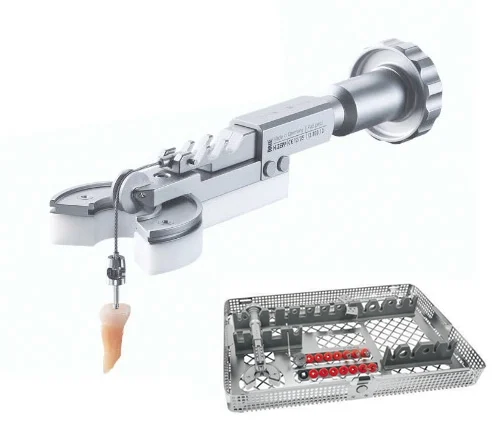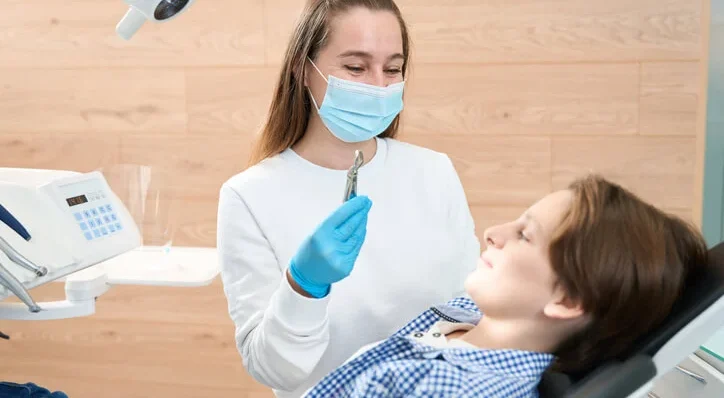Tooth extraction is a common dental procedure often associated with discomfort and anxiety for patients. However, advancements in dental techniques and technologies have paved the way for a more gentle and minimally invasive approach known as atraumatic tooth extraction. This method focuses on preserving surrounding tissues and minimizing trauma to ensure a smoother and less painful experience for the patient. In this article, we will delve into the concept of atraumatic tooth extraction, its benefits, techniques, and its significance in modern dentistry.
Table of Contents
ToggleUnderstanding Atraumatic Tooth Extraction
Atraumatic tooth extraction, also referred to as minimally traumatic or gentle extraction, prioritizes the preservation of surrounding tissues such as bone, gums, and nerves during the removal of a tooth. Unlike traditional tooth extraction methods that may involve significant force and tissue trauma, atraumatic techniques aim to minimize discomfort, reduce postoperative complications, and promote faster healing.
Benefits of Atraumatic Tooth Extraction
- Preservation of Surrounding Tissues
- Reduced Pain and Discomfort
- Faster Healing
- Lower Risk of Complications
Preservation of Surrounding Tissues
By employing gentle techniques and specialized instruments, atraumatic extraction minimizes damage to adjacent bone and soft tissues, preserving their integrity.
Preservation of bone and gum tissue is crucial for maintaining proper support for neighboring teeth and ensuring optimal aesthetic outcomes, particularly in areas visible when smiling.
Reduced Pain and Discomfort
Atraumatic techniques are designed to minimize trauma to surrounding tissues, resulting in reduced pain and discomfort during and after the extraction procedure.
Patients often report less postoperative pain and a quicker recovery period compared to traditional extraction methods.
Faster Healing
With less tissue trauma and minimal disruption to the surrounding structures, atraumatic tooth extraction promotes faster healing and tissue regeneration.
Patients can expect a quicker return to normal activities and reduced downtime following the procedure.
Lower Risk of Complications
The gentle approach of atraumatic extraction reduces the risk of postoperative complications such as excessive bleeding, infection, and nerve damage.
By preserving the integrity of surrounding tissues, the likelihood of complications is significantly minimized, leading to a smoother recovery process.
Techniques of Atraumatic Tooth Extraction
- Preoperative Assessment
- Anesthesia and Sedation
- Minimally Invasive Access
- Gentle Tooth Removal
- Preservation of Surrounding Tissues
- Postoperative Care
Preoperative Assessment
A thorough examination of the patient’s dental and medical history, as well as radiographic evaluation, is essential to assess the complexity of the extraction and identify any potential risk factors.
Preoperative planning helps the dentist determine the most appropriate technique and approach for atraumatic extraction.
Anesthesia and Sedation
Adequate local anesthesia is administered to ensure patient comfort during the procedure.
Depending on the patient’s anxiety level and the complexity of the extraction, additional sedation techniques such as nitrous oxide or intravenous sedation may be utilized.
Minimally Invasive Access
Atraumatic extraction techniques often involve creating a small incision or using specialized instruments to access the tooth and surrounding tissues.
The goal is to minimize tissue trauma while providing adequate access for the extraction process.
Gentle Tooth Removal
Once access is established, the tooth is gently mobilized using precise instruments such as luxators and elevators.
Controlled force is applied to gradually loosen the tooth from its socket, minimizing trauma to surrounding structures.
Preservation of Surrounding Tissues
Special care is taken to preserve the surrounding bone and gum tissue during the extraction process.
Techniques such as socket preservation may be employed to maintain the volume and integrity of the extraction site for future dental implant placement or prosthetic restoration.
Postoperative Care
Following the extraction, patients are provided with postoperative instructions and medications to manage pain and reduce the risk of infection.
Close monitoring of the healing process is essential to ensure optimal outcomes, and patients may be scheduled for follow-up appointments as needed.
Benex Extraction System
The Benex Extraction System is a specialized dental instrument designed to facilitate atraumatic tooth extraction. It consists of a set of unique components that work together to gently remove teeth from their sockets while minimizing trauma to surrounding tissues. The primary components of the Benex system include:
- Benex Extraction Kit
- Screw Adapters
- Extraction Screws
- Handle Assembly
- Tips

Benex Extraction Kit
The Benex kit typically includes a range of components such as handle assemblies, screw adapters, tips, and screws of varying sizes to accommodate different tooth types and extraction scenarios.
The components are designed to provide controlled force application and precise extraction movements, allowing for efficient and gentle tooth removal.
Screw Adapters
Screw adapters are attached to the handle assembly and serve as a connection point for the extraction screw.
They come in various sizes and configurations to accommodate different tooth sizes and extraction needs.
Extraction Screws
Extraction screws are threaded screws that are inserted into the tooth’s root canal or prepared socket to facilitate controlled extraction.
They come in different sizes and designs to match the anatomy of the tooth and provide secure engagement for extraction.
Handle Assembly
The handle assembly serves as the primary interface between the dental professional and the Benex system.
It provides a comfortable grip and allows for precise control of the extraction process, including screw insertion and application of extraction force.
Tips
Tips are specialized attachments that are used in conjunction with the extraction screw to facilitate tooth engagement and extraction.
They come in various shapes and sizes to accommodate different tooth anatomies and extraction scenarios.
Watch the video of atraumatic tooth extraction using Benex
The Benex Extraction System utilizes a unique extraction technique known as controlled-force extraction, which involves the gradual application of force to the tooth to disengage it from the surrounding bone and periodontal ligament. This controlled approach minimizes trauma to the surrounding tissues, resulting in a more atraumatic extraction experience for the patient.
Other Appliances Used for Atraumatic Tooth Extraction
In addition to the Benex Extraction System, several other appliances and instruments are commonly used by dental professionals to perform atraumatic tooth extraction. These include:
- Luxators and Elevators
- Periotomes
- Surgical Drills
- Piezoelectric Devices
- Suturing Materials and Instruments
Luxators and Elevators
Luxators and elevators are specialized dental instruments used to luxate or elevate teeth from their sockets.
They feature thin, sharp tips that are inserted between the tooth and surrounding bone to gently loosen the tooth and facilitate its removal.
Periotomes
Periotomes are delicate dental instruments designed to sever the periodontal ligament fibers that attach the tooth to the surrounding bone.
They feature thin, flexible tips that can be inserted into the periodontal ligament space to facilitate atraumatic tooth dislodgement.
Surgical Drills
Surgical drills are used in cases where the tooth extraction requires additional bone removal or sectioning of the tooth.
They are employed to create an access point in the bone or to divide the tooth into smaller sections for easier extraction.
Piezoelectric Devices
Piezoelectric devices like piezosurgery utilize ultrasonic vibrations to perform precise and controlled bone removal during tooth extraction.
They are particularly useful in atraumatic extraction procedures where preserving surrounding bone is essential.
Suturing Materials and Instruments
Suturing materials such as resorbable and non-resorbable sutures are used to close the extraction socket and promote optimal healing.
Suturing instruments such as needle holders and forceps are used to manipulate and secure sutures during the closure process.
Significance of Atraumatic Tooth Extraction in Modern Dentistry
Atraumatic tooth extraction represents a significant advancement in modern dentistry, offering numerous benefits for both patients and practitioners. By prioritizing the preservation of surrounding tissues and minimizing trauma, this approach enhances patient comfort, reduces postoperative complications, and promotes faster healing. Furthermore, atraumatic extraction techniques contribute to improved aesthetic outcomes and facilitate future dental treatments such as implant placement and prosthetic restoration.
Conclusion
Atraumatic tooth extraction has revolutionized the field of dentistry by offering a more gentle and minimally invasive approach to tooth removal. By prioritizing the preservation of surrounding tissues and minimizing trauma, this technique provides numerous benefits for patients, including reduced pain and discomfort, faster healing, and lower risk of complications. As a cornerstone of modern dental practice, atraumatic extraction techniques continue to evolve, ensuring optimal outcomes and enhancing the overall patient experience in dental care.

